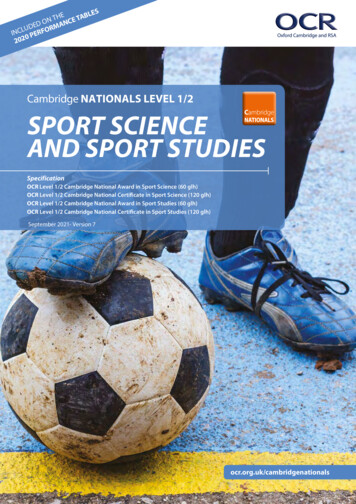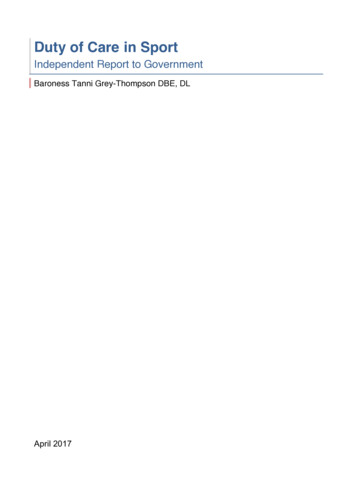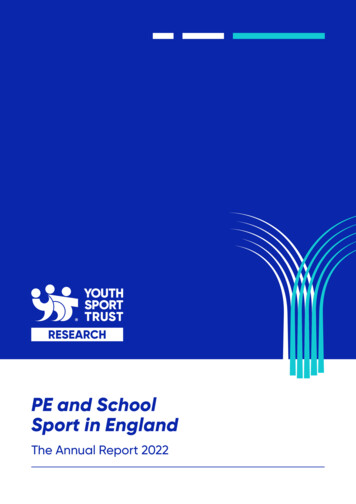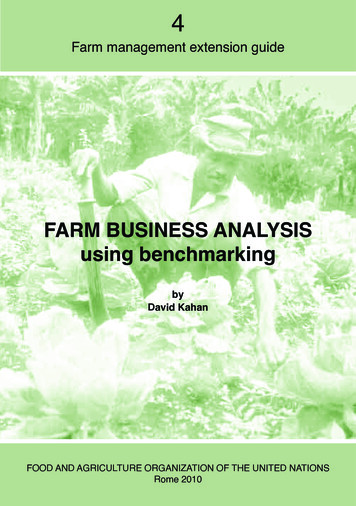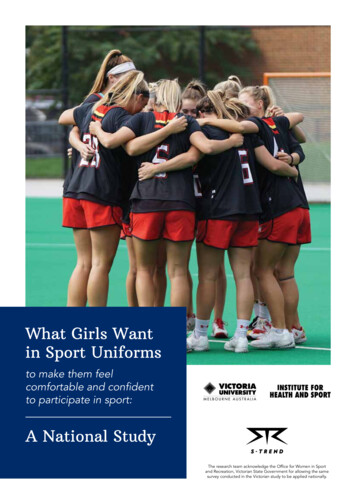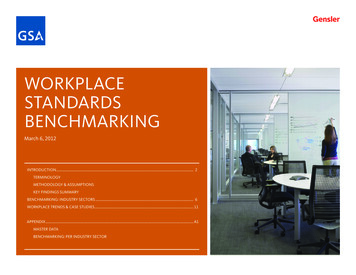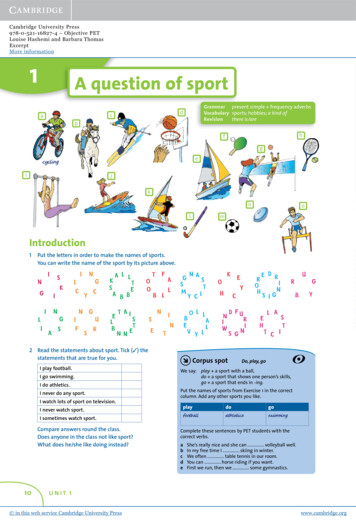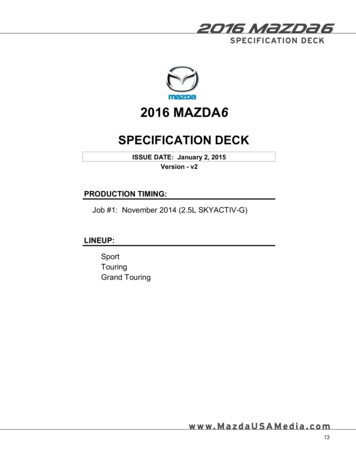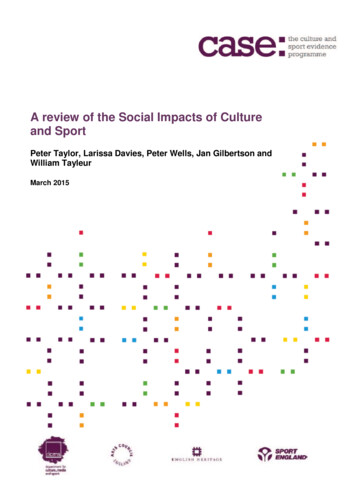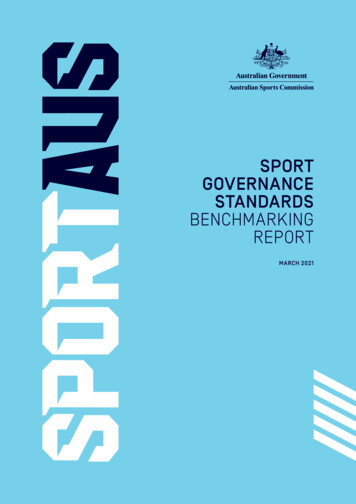
Transcription
SPORTGOVERNANCESTANDARDSBENCHMARKINGREPORTMARCH 2021
CONTENTSIntroduction2Key insights from the self-assessed Sport Governance Standards3Principle 1: The spirit of the game—values-driven culture and behaviours4Principle 2: The team—aligned sport through collaborative governance5Principle 3: The gameplan—a clear vision that informs strategy6Principle 4: The players—a diverse board to enable considered decision-making7Principle 5: The rulebook—documents that outline duties, powers, roles & responsibilities8Principle 6: The playbook—board processes which ensure accountability & transparency9Principle 7: The defence—a system which protects the organisation10Principle 8: The best and fairest—a system for ensuring integrity11Principle 9: The scorecard—embedded systems of internal review to foster continuous improvement12Background131
INTRODUCTIONThe Sport Governance Standards benchmarking report is a document developed by Sport Australia to provide insights forNational Sporting Organisations and National Sporting Organisations for People with Disability (collectively ‘NSOs’). This reporthighlights the findings of how federally funded NSOs assessed themselves against the new Sport Governance Standards (SGS)and will be produced annually.The Sport Governance Standards (SGS) are the measures by which both Sport Australia and NSOs can evaluate the effectivenessand efficiency of their governance systems and processes.These standards, co-designed with the Australian sport sector, focus on accountability and transparency, with the mainaim being continuous governance improvement in all sporting organisations.In total, there are 37 Sport Governance Standards across the nine Sport Governance Principles. NSOs were asked toself-evaluate their governance maturity against each standard using a four point scale, with a score of 1 representinglow maturity, and a score of 4 representing the highest level of maturity.The SGS data in this document will be used by NSOs and Sport Australia’s Governance and Organisational Enhancement team to: benchmark the current governance maturity of all NSOs. This will form the basis of a Sport’s Governance and OrganisationalEnhancement Plan determine the SGS that will be annually publicly reported by SportAUS for each NSO; and identify the major development needs of the NSOs to prioritise support, education and resources for the sector.2
KEY INSIGHTSfrom the self-assessed Sport Governance StandardsAverage standard score2.95/4 — The average self-assessed score for a Standard (across the 9 Principles) for all NSOsCollaborative GovernanceThe highest-scoring Standard across the sector was Standard 2.3 — ‘The organisation proactively engages, communicatesand collaborates with its members, ensuring accountability and transparency’, which is somewhat inconsistent with thecurrent issues presented to the Governance team on various fronts. Without diminishing the good work of many NSOs, giventhat this Standard does not map to a clear outcome, it is possible that the self-assessed nature of the evaluation reveals adiscrepancy between perception and reality.Values, Culture and BehavioursPrinciple 1 has two corresponding Standards which measure both the board’s utilisation of a code of conduct to set theexample for the organisation; and the level to which the board engages with its stakeholders to establish, define andcommunicate its core values and behaviours. Consistently, NSOs reported, at best, under-utilisation of the Code of Conduct,and at worst none at all. In addition, NSOs also reported that there was room for improvement in the level of stakeholderengagement used to establish, define and publishes their core values and associated behaviours, and the communicationof those values and behaviours across the sport.Board CompositionPrinciple 4 — ‘The Players’ — revealed a disparity in results for board diversity. While gender diversity was the second-highestscore in the assessment (3.5 out of 4), NSOs scored lowly in the Standard related to developing and achieving broaderdiversity targets within its board composition. Further, 71% of NSOs reported that all elected and appointed directors wereindependent and had no conflicts, achieving the maximum score for that Standard.IncorporationOne of the most objective SGS measures is the assessment of an organisation’s legal status. This standard achieved thefourth lowest average score (2.4 out of 4), with 85% of NSOs stating ‘Our board has commenced discussions regardingtransitioning to a legal entity under their jurisdiction’s relevant legislation’.Board Performance and EvaluationBoard performance evaluation has consistently achieved low scores over numerous NSOs governance reviews. This Standardachieved the second-lowest score (2 out of 4), indicating a need for improvement in the evaluation of Boards and Directorsand the implementation of resultant action plans. To support the sector, Sport Australia has recently developed (and ispiloting) an updated board evaluation tool designed to provide alignment with the new Principles and Standards.Succession PlanningConsistent with previous industry assessments (Mandatory Sport Governance Principles 2016 and 2018), NSOs continue toscore Succession Planning at the lowest end of the scale, with an average score of 1.7 out of 4).3
PRINCIPLE 1:THE SPIRIT OF THE GAME—VALUES-DRIVENCULTURE AND BEHAVIOURSAn organisation’s culture and behaviours should be underpinned by values which are demonstratedby the board and embedded in its decisions and actions.2.7PER PRINCIPLE SCORE0.51.01.52.02.53.03.54.0Averageall NSOsStandard1.1The board have a directors’ code of conduct which outlines the high standards of professional andethical conduct expected by directors in the interests of members2.41.2The organisation actively engages with its stakeholders to establish, define and publishes its corevalues and associated behaviours2.9INSIGHTS AND OBSERVATIONS Standard 1.1 registered the fifth lowest score across all NSOs, with only 15% of NSOs scoring a 4 whichstates ‘Our board has a published directors’ code of conduct, which is reviewed annually by the board(and with input from stakeholders) and annually executed by all directors. The code directly integratesbehavioural expectations with the organisation’s value’. Further, for Standard 1.1, 11% of NSOs scored a 1 which states ‘Our board does not have a directors’code of conduct’.4
PRINCIPLE 2:THE TEAM—ALIGNED SPORT THROUGHCOLLABORATIVE GOVERNANCEAcross a sport, boards should work together to govern collaboratively and create alignment to maximiseefficient use of resources and implement whole-of-sport plans.3.3PER PRINCIPLE SCORE0.51.01.52.02.53.03.54.0Averageall NSOsStandard2.1The board develops and publishes a strategy for engaging with, and listening to, the organisation’smembers and stakeholders (including boards of their member; bodies)3.02.2The board identifies and implements opportunities to meet with and collaborate regularly with theboards of their member bodies3.42.3The organisation proactively engages, communicates and collaborates with its members, ensuringaccountability and transparency3.6INSIGHTS AND OBSERVATIONS The Standards measuring Principle 2 scored consistently strong, with Standard 2.3 relating to engagement,communication and collaboration the highest-scoring Standard across all 37 in the self-assessment. For Standard 2.3, 71% of NSOs scored 4 which stated ‘The organisation regularly and proactivelycommunicates with its members and provides regular forums where members are given the opportunityto provide feedback and input on the direction of the organisation’. The Sport Governance & Organisational Enhancement team will be undertaking a validation process withtargeted NSOs as it relates to Standard 2.1, 2.2 and 2.3, as this self assessed scoring reflects differently towhat the team has seen in practice in the sector.5
PRINCIPLE 3:THE GAMEPLAN—A CLEAR VISION THATINFORMS STRATEGYThe board is responsible for overseeing the development of the organisation’s vision and strategy as well asdetermining what success looks like.3.0PER PRINCIPLE SCORE0.51.01.52.02.53.03.54.0Averageall NSOsStandard3.1The organisation has adopted, in consultation with its members, a strategic plan with clear andmeasurable targets which link to a detailed operating budget3.0INSIGHTS AND OBSERVATIONS Standard 3.1 achieved a moderate score (equal to the average for all Standards). Only 15% of NSOs scored 4 for this Standard, which states ‘Our organisation has a whole of sport strategicplan which is endorsed and implemented consistently and effectively by our member bodies. The plan hasmeasurable objectives and a detailed three-year forward financial model that is compared with historical’. 13% of NSOs scored a 2 ‘Our organisation has a strategic plan with no accompanying budget’.6
PRINCIPLE 4:THE PLAYERS—A DIVERSE BOARD TO ENABLECONSIDERED DECISION-MAKINGA board should be a diverse group of people who collectively provide different perspectives and experience tofacilitate more considered decision-making.3.0PER PRINCIPLE SCORE0.51.01.52.02.53.03.54.0Averageall NSOsStandard4.1The board should have a diverse mix of skills, expertise and experience in order to meet the strategicgoals of the organisation3.34.2The board demonstrates a strong and public commitment to progressing towards achieving its diversitytargets within its board composition including: Geographical locality, Aboriginal and Torres Strait Islander,CALD, Age, SES, Disability, Sexual Orientation, Gender Identity, Race, Religion2.14.3The board, while ensuring the prevailing criterion for election is eligibility, skills, expertise andexperience should be composed in a manner such that no gender accounts for more than 60% ofthe total number of Directors3.54.4The organisation’s directors should be independent, regardless of whether elected or appointed3.54.5The organisation has a documented and transparent process for the identification andappointment of directors3.14.6The board has a composition which incorporates both elected and appointed directors2.7INSIGHTS AND OBSERVATIONS There is considerable discrepancy within this Principle in regard to scores, with the equal second-highestscores being for 4.3 and 4.4, yet the third-lowest score for 4.2 (board diversity). 4.4 measures board independence, and 71% of NSOs scored 4 ‘All elected and appointed directorsare independent and have no conflicts’. 4.3 relates to gender balance, which is a very positive result; further:— No NSO scored a 1 ‘Our board has more than 90% of one gender’— 13% of NSOs scored a 2 ‘Our board has more than 80% of one gender’— 22% of NSOs recorded a 3 ‘Our board has more than 70% of one gender’— 65% of NSOs recorded a 4 ‘Our board has no gender which accounts for more than 60% or less than40% of the total number of Directors’.7
PRINCIPLE 5:THE RULEBOOK—DOCUMENTS THAT OUTLINE DUTIES,POWERS, ROLES & RESPONSIBILITIESAn organisation should clearly define and document its structure and the duties, responsibilitiesand powers of members, directors, committees and management.2.9PER PRINCIPLE SCORE0.51.01.52.02.53.03.54.0Averageall NSOsStandard5.1The organisation should be a legal entity incorporated under the legislation which best fits its size,need and jurisdiction2.25.2The organisation should have a staggered rotation system for directors, with term limitsand a maximum tenure of no longer than 10 years. A director may serve on the Board for amaximum of 12 years if appointed as chair of the organisation or to a senior position withan international federation3.45.3A director who has completed the maximum term on the board is not eligible to stand as a directorfor that organisation for a period of at least three years2.95.4The board has a process for inducting new directors3.15.5The board operates under a documented board charter**** Technical issue prevented this Standard being enteredINSIGHTS AND OBSERVATIONS Standard 5.1 was the fourth-lowest score in the assessment:— 9% of all NSOs scored 4 ‘Our organisation is a legal entity under our jurisdiction’s relevant legislationand we comply with this legislation’.— 85% of all NSOs scored 2 ‘Our board has commenced discussions regarding transitioning to a legalentity under their jurisdiction’s relevant legislation’.— The Sport Governance & Organisational Enhancement team will be undertaking a validation processwith targeted NSOs to gain further insights as to why this standard scored so lowly, noting it is arequirement of the NSO recognition agreement to be a Company Limited by Guarantee.8
PRINCIPLE 6:THE PLAYBOOK—BOARD PROCESSES WHICH ENSUREACCOUNTABILITY & TRANSPARENCYThrough effective processes and continual review of its performance, the board is able to demonstrateaccountability and transparency to its members and stakeholders.3.0PER PRINCIPLE SCORE0.51.01.52.02.53.03.54.0Averageall NSOsStandard6.1The organisation has a Finance, Audit and Risk committee3.36.2The board shall appoint the chair and evaluate their performance2.66.3The board shall ensure that the CEO, upon leaving their role, is not appointed or elected to theboard within 3 years3.36.4The board has rigorous processes for identifying and managing director conflicts of interest3.46.5The organisation reports on governance outcomes at both its Annual General Meeting (AGM)and in its Annual Report2.7INSIGHTS AND OBSERVATIONS Out of the five measures, there were two low averages of note. Only 5% of all NSOs scored a 4 ‘Our organisation has a chair elected by the board, with a clearly definedand reviewed position description and a documented process for this election. The Chair’s performanceis assessed bi-annually and a development action plan created and implemented’. Standard 6.5 (reporting governance outcomes at AGM & annual report) saw only 13% of all NSOs reportinga 4 ‘Our organisation reports on governance outcomes at its AGM and in its annual report. We provide an‘If not, why not’ statement as to why we haven’t met the Sport Governance Standard/s and outline plansto meet the standard/s going forward’.9
PRINCIPLE 7:THE DEFENCE — A SYSTEM WHICH PROTECTSTHE ORGANISATIONTo proactively protect the organisation from harm, the board ensures the organisation has and maintainsrobust and systematic processes for managing risk.3.1PER PRINCIPLE SCORE0.51.01.52.02.53.03.54.0Averageall NSOsStandard7.1The organisation has a documented process to ensure compliance with working with vulnerablepersons legislation (that reflects the varying legislative requirements of all States and Territories)including maintenance of relevant checks3.27.2The board has a documented process for ensuring that the policies and procedures implementedby management are consistent with the organisation’s risk management framework2.9INSIGHTS AND OBSERVATIONS Standard 7.1 (compliance with vulnerable persons legislation) achieved a solid result, however oneNSO scored 1 ‘Our organisation does not have a documented process for workers/volunteers workingwith vulnerable persons’ and 15% of NSOs scored 2 ‘Our organisation has a documented process forworkers/volunteers working with vulnerable persons but it is not a national policy’. Standard 7.2 relates to Risk, and 9% of NSOs scored 1 ‘Our organisation does not have a riskmanagement framework or associated policies’; further, 27% of NSOs reported having policies howeverthese were not regularly reviewed or reported against ‘Our organisation has policies associated with themanagement of risk’ achieved a score of 2.10
PRINCIPLE 8:THE BEST AND FAIREST — A SYSTEM FORENSURING INTEGRITYAn organisation should have measures and protocols to ensure integrity of the sport and safeguard its participants.3.0PER PRINCIPLE SCORE0.51.01.52.02.53.03.54.0Averageall NSOsStandard8.1The organisation maintains an appropriate stakeholder education and communication plan for itsintegrity framework2.68.2The organisation has a defined process for reporting integrity issues (e.g. bullying, corruption,harassment, doping) throughout the organisation and escalation to the board and Sport IntegrityAustralia where appropriate3.28.3The organisation has clearly defined processes for resolving NSOs related disputes that include bothinternal means of handling complaints, and external dispute resolution mechanisms3.38.4The organisation’s Member Protection Policy and Child Safeguarding Policy are compliant with SportAustralia and Sport Integrity Australia requirements3.48.5The organisation has established mechanisms to create a culture that promotes inclusion, safetyand good behaviour through codes of behaviour and education to support their Member ProtectionPolicy and Child Safeguarding Policy2.78.6The organisation has a Sport Integrity Australia approved Anti-Match-Fixing Policy3.1INSIGHTS AND OBSERVATIONS Principle 8 involves measures which have seen significant investment and improvement over the pastseveral years in regard to Integrity, however there are two Standards which highlighted areas requiringattention in the immediate future:— Standard 8.1 is about stakeholder education and communication, and 27% of NSOs achieved a scoreof 1 ‘Our organisation does not have a stakeholder education and communication plan in place forour integrity framework’, with a further 18% not having a national plan (score of 2).— Regarding Standard 8.5, whilst all NSOs reported having codes of behaviour, 44% reporting notproviding education to promote inclusion, safety and good behaviour (score of 2).11
PRINCIPLE 9:THE SCORECARD — EMBEDDED SYSTEMS OF INTERNALREVIEW TO FOSTER CONTINUOUS IMPROVEMENTThe board must have an appropriate system of internal controls to enable it to monitor performance,track progress against strategy and address issues of concern.2.7PER PRINCIPLE SCORE0.51.01.52.02.53.03.54.0Averageall NSOsStandard9.1The board should regularly evaluate its performance and performance of individual directors. Theboard should agree and implement a plan to take forward any actions resulting from the evaluations2.09.2The board will operate itself in an efficient manner and directors meet as appropriate to dischargetheir duties effectively3.39.3The board has documentation and processes to operate its meetings in an efficient andeffective manner3.59.4The board maintains accurate records of meetings and board decisions3.19.5The board has documented financial delegations. This includes, but is not limited to: expenditure,funding, grants, other financial transactions as resolved by the board3.09.6The board has documented non-financial delegations. This includes, but is not limited to: staffing,public relations, strategic actions, business plans, board resolutions, grievances and complaints2.69.7The board has a documented CEO performance evaluation process2.79.8The board has a documented succession planning process for key personnel and the retention ofcorporate knowledge1.7INSIGHTS AND OBSERVATIONS Principle 9 provided the highest discrepancy of scores within a Principle, with the equal second-highestscore of 3.5 for Standard 9.3 (meeting documentation and processes) to the lowest overall score in 1.7for Standard 9.8 (succession planning). Standard 9.1 was the second-lowest of all scores, demonstrating the sector, on average, does noteffectively or sufficiently evaluate board or director performance.12
BACKGROUNDIn August 2020, Sport Australia, in partnership with our colleagues from the State and Territory Agencies for Sport andRecreation, launched a new co-designed Sport Governance Framework. This framework incorporates the evolved SportGovernance Principles, new educational and support resources as well as a new evaluation and assurance system(the Sport Governance Standards).The Evaluation and Assurance system has a greater focus on transparency, accountability and provision of ongoing supportfor continual improvement. This report, a combination of data from 64 NSOs, including 38 funded Olympic/Paralympic NSOs, isdesigned to provide insights for NSOs into the results and findings of the self-assessment process against the new SGS.Limitations of this reportThe data in this report is predominantly self-reported by NSOs. Sport Australia has reviewed the submitted data for obviouserrors. However, due to the nature of self-reporting, Sport Australia is not able to independently verify all data in this report.Why have standards?The SGS are an organisational governance evaluation tool. Sport Australia will be able to identify, advise, support, resource,and educate partners and, in turn, work with NSOs to continually improve their governance systems and processes. Similarly,State/Territory agencies are able to adopt the SGS to assist sporting organisations in their jurisdiction.The standards enable accountability to both Federal and State Governments who provide significant investment to sportingorganisations. This is coupled with members and participants, who have high expectations that sport at every level will beadministered with the highest level of integrity and good governance. Finally, the SGS establish a transparent accountabilityframework that is publicly reported which evaluates a NSO’s adherence to the expected level of governance maturity.Additionally, the SGS are intended to offer clear leadership on how improvement can be measured. The language is suchthat the SGS are applicable to all sporting organisations no matter size, jurisdiction or maturity.How many standards are there?Replacing the Mandatory Sport Governance Principles, there are 37 SGS across the 9 Sport Governance Principles,bringing the principles to life in practice.Engagement with other agenciesSport Australia will share the report, its finding and insights with other government agencies including Sport IntegrityAustralia and State and Territory Agencies for Sport and Recreation. Sport Australia will engage with these relevantagencies in the development of Governance and Organisational Enhancement Improvement plans for identified NSOs.AcknowledgementThe Sport Governance and Organisational Enhancement team would like to acknowledge the invaluable contributionof the State and Territory Sport and Recreation Departments, as well as the NSO and state sporting organisation leaderswho provided their time and expertise to the development of the Governance Principles and accompanying Standards.Further, the team would like to thank our colleagues at Sport Australia, in particular the Partner Portal team who helpedto deliver a vital new system for self-assessment directly contributing to increasing capability across the sector.OmissionDue to an unforeseen technical issue at the time the self-assessment went live, Standard 5.5 ‘The board operates undera documented board charter’ was not measured.13
SportAus.gov.auASC36103Leverrier Street Bruce ACT 2617PO Box 176 Belconnen ACT 2616 61 2 6214 1111
and efficiency of their governance systems and processes. These standards, co-designed with the Australian sport sector, focus on accountability and transparency, with the main aim being continuous governance improvement in all sporting organisations. In total, there are 37 Sport Governance Standards across the nine Sport Governance Principles.
